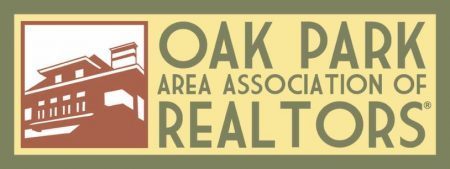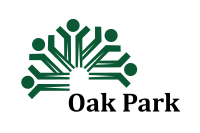Location: Oak Park is located eight miles west of the Chicago loop. Oak Park is bounded on the north by North Avenue, on the east by Austin Boulevard, on the south by Roosevelt Road and on the west by Harlem Avenue. Click here for Map. For more information about the Village of Oak Park, please check out the Community Information Sheet provided by the Village of Oak Park.
History: The Village of Oak Park evolved from the 1837 purchase of land, now bounded by Lake Street, Chicago Avenue, Oak Park Avenue and Harlem Avenue, by early settler Joseph Kettlestrings. The home he built on the southwest corner of that tract was the first house in Oak Park. In the 1850s, Kettlestrings began to subdivide his land, selling it to “good people who were against saloons and for good schools and churches.”
In the mid 1880’s, J. W. Scoville acquired 185 acres of land north of Chicago Avenue between Oak Park Avenue and Austin Boulevard. Other settlers moved in slowly until the Chicago Fire in 1871 which caused an exodus of Chicagoans into Oak Park, giving the village its first population boom.
Oak Park was incorporated as a village in 1902. At that time, Oak Park was 50% developed, predominantly by single-family residences mixed with large areas of apartment houses and fringed with commercial development. Click here for more history.
Architecture: The Village of Oak Park, a thriving community of more than 53,000 people, is known for its architectural heritage. Comfortable Victorian homes stand alongside Prairie style structures designed by Frank Lloyd Wright and his contemporaries.
Oak Park has come to represent a distinctive urban/suburban lifestyle that is a mix of these architecturally significant homes, lovely shaded streets and expansive parks. Within its 4.7 square miles lives a diverse mix of people with different cultures, races, ethnicities, professions, lifestyles, religions, ages, and incomes.
Government: Oak Park is a Home-Rule community run by an elected Village President, six Village Trustees and a Village Clerk, as well as an appointed Village Manager. Click here for more details.
Education: Elementary School District 97 supports eight public neighborhood elementary schools (K-5) and two public middle schools (6-8). The Oak Park and River Forest community is also home to an extensive Catholic school system, two Montessori schools and Christian and Lutheran schools.
Students from Oak Park attend Oak Park and River Forest High School. First established in 1899, when high school District 200 was formed with River Forest, the school’s primary goal remains the same: “to enrich the lives of our students so that they may fulfill the mission of the school ‘to reach their full human potential.’
Oak Park is also the home of Fenwick High School a private Dominican Catholic college preparatory high school.
Transportation: Two CTA lines (the Blue and the Green) and the Metra, the suburban rail service, both run through Oak Park.
Oak Park is also easily accessible by the Eisenhower Expressway (I290) which runs through the village and connects Oak Park to downtown Chicago and the western suburbs. (The Austin & Harlem expressway exits and entrances are on the LEFT side.)
Oak Park is ten miles from O’Hare International Airport and eight miles from Midway Airport.
Arts and Culture: The performing, visual, craft and literary arts are thriving in Oak Park. From the Harrison Street Art District, the many galleries on Lake and Marion Streets and the variety of musical performance venues, to the innumerable artists, artisans, graphic artists, musicians, writers and indigenous theatre groups, Oak Park is the hub for a lively arts community often supported by The Oak Park Area Arts Council.
Points Of Interest:
- Frank Lloyd Wright Home & Studio. The home and studio of America’s most renowned architect is open daily for guided interior tours. As Wright’s personal design laboratory for the first twenty years of his career, this National Historic Landmark features some of the most spectacular spaces in American architecture.
- Ernest Hemingway Museum. The Hemingway Museum is the perfect way to begin exploring the impact Ernest Hemingway’s Oak Park upbringing had on one of America’s greatest authors. The first twenty years of Hemingway’s life are the subject of the Museum’s exhibitions and videos.
- Pleasant Home Recently designated a National Historic Landmark, Historic Pleasant Home is an excellent example of an early Prairie style mansion. This thirty-room residence, set on a four-acre park, was designed in 1897 by Prairie School architect George W. Maher for millionaire banker John Farson.
- Unity Temple Designed in 1905 and completed in 1908, Unity Temple is the last surviving public building of Frank Lloyd Wright’s early “Prairie School” period. It is one of the most complex and exciting spaces in 20th century architecture.
- The Oak Park Conservatory was built in 1929 and contains three separate environments: a tropical, fern and desert room as well as a Show House in which seasonal floral and foliage displays are mounted each month of the year.
Library: The Oak Park Public Library has a Main branch, located in the center of the village, as well as two smaller branches – Dole which is located in the northeast side of the Village and Maze which is located in the southeast corner of the village. The Oak Park Public Library is a member of the Suburban Library System.
Park District: In partnership with the community, we enrich lives by providing meaningful experiences through programs, parks, and facilities. Park District of Oak Park.
Shopping: Oak Park has several charming shopping districts composed of restaurants, small, family-owned businesses, specialty shops and more including Downtown Oak Park.
Oak Brook Shopping Mall, known for its outstanding mix of retailers and its beautiful outdoor ambiance, is located approximately eight miles west of Oak Park. The center offers six premiere department stores, including Nordstrom’s, Saks Fifth Avenue, Neiman Marcus, Macy’s, Lord & Taylor and Sears.
Local Newspapers: The Wednesday Journal and The Oak Leaves.

